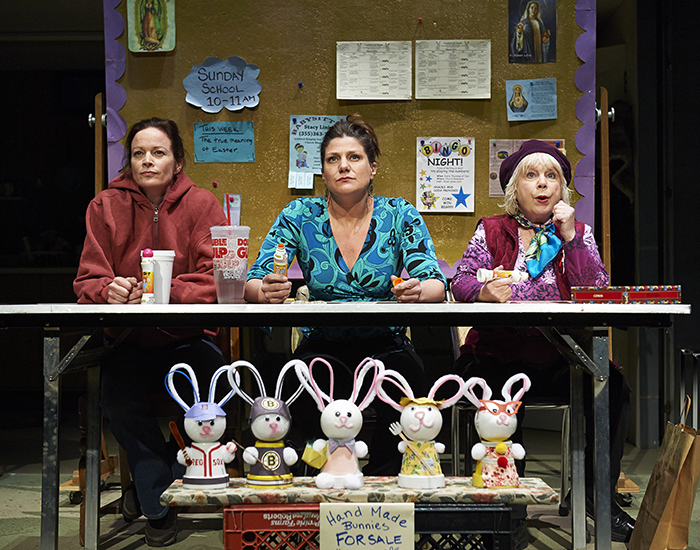Who are “Good People?” This is what Margie Walsh calls her one time friend and lover, Mike Dillon just after “busting balls” about how he has become “lace-curtain.” A phrase that describes parvenu middle-class Irish who want to assimilate into mainstream American culture to distance themselves from their working class roots, the term is also the ultimate insult in Southie, the blue-collar Boston neighborhood home of the characters.
Word choice is important in Good People, easily Cleveland Playhouse’s best and funniest play of the whole season. It’s a play about personal relationships between people struggling in a time of high unemployment in a tough neighborhood and the relationship between the rich and the poor. But thankfully, it doesn’t hammer the audience with a message. Instead, as it tells its story, the play develops a delightful ambiguity about who the good people really are in the show.
Without exception, the characters are deeply flawed. It’s not that their actions are good or bad, but rather that the decisions they make and the circumstances in which they live force them to take a position and defend it somewhere in the vast gray sea between black and white.
This makes the characters very dynamic and quite funny; not every justification the characters use makes sense, and they don’t care. The flawed nature of the characters also makes them incredibly sympathetic and reveals just how human they are.
The play follows the story of Margie Walsh (Kate Hodge), a tough blue-collar woman from Southie who takes care of her 20-year-old mentally disabled daughter Joyce. When the play begins, she has just been fired from her job at the dollar store by Stevie (Patrick Halley) for being late almost every morning. Margie is late because her unreliable and greedy landlord Dottie (Denny Dillon) won’t get up on time to watch Joyce.
The interplay and antagonism between the characters in these early scenes are hilarious. Margie’s friend Jean (Elizabeth Rich), partly out of revenge for firing Margie and partly out of spite, tells Margie that Stevie is “gay” for going to bingo, even telling him to his face at the next opportunity when he shows up at the bingo hall.
Meanwhile, if Dottie’s not trying to squeeze another buck out of Margie, she’s trying to foist homemade craft rabbits, made out of Styrofoam balls and plant pots, onto any unsuspecting victim unlucky enough to sit down at her table at bingo. The interplay between Dottie and Jean is some of the funniest in the play, and Jean’s exasperation at Dottie’s behavior is palpable across the stage.
The second part of the play focuses almost exclusively on Margie’s relationship to Mike Dillon (David Andrew MacDonald). Margie hears that Mike is in town through Jean and, on account of their former relationship, thinks he might be able to help her find a job.
But it’s clear from the first moment we get a glimpse of him that Mike is no saving angel. He sits smugly behind his desk, proud to the point of arrogance of his achievements and how far he has come from his humble beginnings in Southie.
When he stands up to put on his doctor’s coat (that sacred article of clothing that signifies the glory and status of physicians, which goes beyond that of a healer and which some doctors are so attached to that they will not even remove it to use the bathroom), it’s as if he is a military officer, waiting to receive his distinction.
It’s not that Mike is a bad person. In fact, he’s a generally kind fellow who works as a doctor, specialized in fertility treatments, has a family, and gives to charity. Macdonald does an excellent job of portraying these two conflicting sides of Mike’s character and in the scenes with Margie, the audience can see how the pride and arrogance of achievement bubbles just underneath the surface of middle-class politeness.
It’s clear right away that Margie makes Mike uncomfortable. She is a living reminder of Southie, the real Southie, and not the one that Mike has re-imagined for himself. This comes to a head when Margie meets Mike’s wife Kate (Zoey Martinson).
Kate is the most pitiable character but not the most sympathetic. She’s a very nice person (certainly more welcoming to Margie than Mike when Margie shows up uninvited) but she’s also a snob, which is clear when she asks Margie if the wine tastes “cork.” She asks Margie what life in Southie was really like with a typical bourgeois curiosity that wants to observe but never really get close to real danger.
When Margie tells her how Mike got into a serious fight, Kate is disgusted. As the play goes on, it becomes clear that Mike has gotten further and further away from his identification to Southie and wants nothing to do with Margie.
The play ends with a brilliantly executed climax that captures the realistically awkward confrontation between two former lovers who are now truly worlds apart. It also serves as a shattering indictment of the hypocrisy of the bourgeois class. In the end, it may not be clear who the “good people” are, but it is clear that Mike is not one of them.
Finally, the set of Good People deserves maybe as much praise as the story. It’s not so much the individual set pieces that are amazing, as it is the way they appear and the seamlessness of the transitions. A wall slides up in a back alley to reveal a naturalistic rendition of Margie’s small blue-collar abode. Later, a larger section slides up and continues sliding until it has revealed the palatial home of Mike and his wife. When this set piece was revealed, it was the first time I had ever heard of the audience clapping just for the scenery, but it was more than well deserved.


